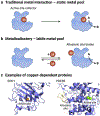Metalloallostery and Transition Metal Signaling: Bioinorganic Copper Chemistry Beyond Active Sites
- PMID: 36653724
- PMCID: PMC10754205
- DOI: 10.1002/anie.202213644
Metalloallostery and Transition Metal Signaling: Bioinorganic Copper Chemistry Beyond Active Sites
Abstract
Transition metal chemistry is essential to life, where metal binding to DNA, RNA, and proteins underpins all facets of the central dogma of biology. In this context, metals in proteins are typically studied as static active site cofactors. However, the emergence of transition metal signaling, where mobile metal pools can transiently bind to biological targets beyond active sites, is expanding this conventional view of bioinorganic chemistry. This Minireview focuses on the concept of metalloallostery, using copper as a canonical example of how metals can regulate protein function by binding to remote allosteric sites (e.g., exosites). We summarize advances in and prospects for the field, including imaging dynamic transition metal signaling pools, allosteric inhibition or activation of protein targets by metal binding, and metal-dependent signaling pathways that underlie nutrient vulnerabilities in diseases spanning obesity, fatty liver disease, cancer, and neurodegeneration.
Keywords: Copper Fluorescent Sensor; Cuproplasia; Cuproptosis; Metalloallostery; Transition Metal Signaling.
© 2023 Wiley-VCH GmbH.
Conflict of interest statement
Conflict of Interest
The authors declare no conflict of interest.
Figures





References
-
- Lippard SJ, Berg JM, Principles of Bioinorganic Chemistry, University Science Books, Mill Valley, CA, 1994.
-
- Que EL, Domaille DW, Chang CJ, Chem. Rev 2008, 108, 1517–1549. - PubMed
-
- Rosenzweig AC, O’Halloran TV, Curr. Opin. Chem. Biol 2000, 4, 140–147. - PubMed
-
- Kim B-E, Nevitt T, Thiele DJ, Nat. Chem. Biol 2008, 4, 176–185. - PubMed
-
- Andrews NC, Schmidt PJ, Annu. Rev. Physiol 2007, 69, 69–85. - PubMed
Publication types
MeSH terms
Substances
Grants and funding
LinkOut - more resources
Full Text Sources
Other Literature Sources

